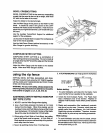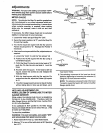
CUTTING PANELS
When cutting panels (whenever fence is positioned
outside of table surface), ALWAYS use the Auxiliary
Fence/Work Support.
1. Unlock Fence and raise rear end.
2. PositionAuxiliary Fence/Work Support as shown and
attach it with two "C" clamps.
RABBETING
AUXILIARY PANEL/
RABBETING is known as cutting out a section of the
comer of a piece of material, across an end or along an
edge.
To make a RABBET requires cuts which do not go allt he
way through the material. Therefore, the Blade Guard
must be removed.
1. Remove Blade Guard.
RABBET
FIRST CUT 1
I SECOND CUT
t
2. For rabbeting along an edge (long way of work-
piece) as shown, add facing to Rip Fence approxi-
mately as highas the workpiece is wide. Adjust Rip
Fence and blade to required dimensions; then make
first cut with board flat on table as any rip(type) cut;
make second cut with workpiece on edge. Follow all
precautions, safety instructions,and operational in-
structions as for dpping, or riptype operations, includ-
ing Featherboards and Push Stick, etc.
3. For rabbeting across an end, for workpiece 10-1/2
inches and narrower, make the rabbet cut with the
board flat on the table. Using the Miter Gauge fitted
with a Facing, follow the same procedures and in-
structions for cross cutting making successive cuts
across the width of the workpiece to obtain the de-
sired width of cut. DO NOT use the Rip Fence for
rabbeting across the end.
4. INSTALL BLADE GUARD IMMEDIATELY UPON
COMPLETION OF RABBETING OPERATION.
Rabbet cuts can also be made in one pass of the
workpiece over the cutter using the Dado Head or
Molding Head.
RABBETING ALONG
THE EDGE
/
/
/
./
RABBETING
ACROSS THE END
J
/
J
/
/
PLOUGHING AND MOLDING
PLOUGHING is grooving withthe grain the long way of
the workpiece, using the Fence, USE featherboards
and push sticks as required.
MOLDING is shaping the workpiece with the grain the
long way of the workpiece, using the Fence. Use
featherboards and push sticks as required.
PLOUGHING
MOLDING
37


















